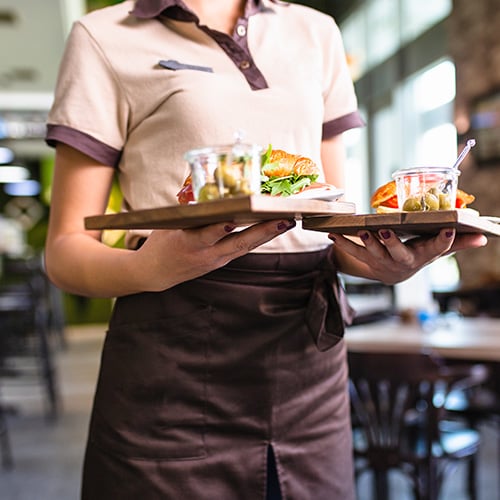
Maintaining a professional and polished appearance is crucial for any business, and the restaurant industry is no exception. Not only do dress code standards aid in workplace hygiene, they also promote a sense of belonging and reinforce staff roles as representatives of the establishment. This unity extends beyond the team and impacts customers, who can easily identify staff members and seek assistance when needed. We've created a guide that outlines how to create effective restaurant dress codes and how to implement them, allowing you to reap the benefits a strong dress code policy provides.
Shop All Restaurant UniformsWhat Is a Restaurant Dress Code Policy?

An employee dress code policy is a written guide that outlines the company rules in regards to employee clothing, uniforms, grooming, and overall appearance. The restaurant dress code should be included in the employee handbook and reviewed with all new staff members.
Benefits of Dress Code
Restaurant dress codes offer several benefits for employers and staff members. Most importantly, a dress code helps your employees to choose the appropriate work attire so you can focus on other important tasks. But in addition to that, a standard of dress will also help in these areas:
- Guest First Impressions - Clean, well-fitting uniforms and good personal hygiene make your front-of-house staff appear professional to your guests.
- Identification - Dress codes and uniforms make your staff members more identifiable to guests and other employees.
- Restaurant Branding - You can enhance your restaurant branding by extending it to your staff uniforms. Server clothing and aprons can be customized with your restaurant’s name and logo.
- Team Morale - Uniforms should help inspire a sense of pride, authority, and camaraderie among employees.
- Safety - A dress code isn't necessary for appearance regulation alone. In the back of the house, non-slip shoes prevent trips, while chef's coats and chef pants can prevent burns.
How to Write a Dress Code Policy
It helps to break your dress code into easy-to-read sections. Include the following information in your written dress code policy:
- Dress Code Purpose - A brief statement that addresses the importance of a dress code helps your employees to understand its purpose.
- Dress Code Guidelines - This is the meat of your dress code policy. Outline all aspects of the restaurant employee dress code, from personal grooming to bodily hygiene.
- Accommodations - Use this space to specify your accommodations. For example, you should allow exceptions to the dress code for religious expression, cultural dress requirements, and disabilities.
- Employee Acknowledgement - Request a signature from all new employees to show they have read and understand the dress code policy.
Note: Before making your dress code official, consult with legal council to ensure you are abiding by all state and local regulations. Your attorney should also review the dress code to check for language or rules that could be considered discriminatory.
What to Include in a Dress Code

We've made a list of the common topics covered under a foodservice dress code. Every dress code is different, so use our dress code list as a starting point when you write your policy.
- Uniform Employees - If you provide uniforms, specify what articles of clothing you will provide and what items need to be purchased by the employee. For instance, you might provide chef coats and a neckerchief, but not footwear. Also list any specific requirements related to uniform style, color, and brand to help employees purchase the right items.
- Non-Uniform Employees - Some employees wear their own personal clothing instead of a uniform, like managers, host staff, and sometimes bartenders. You can help them choose an appropriate work outfit by specifying a formal, business casual, or casual dress code. Beyond that, you might also have requirements related to color, fit, and style.
- Personal Clothing - In your dress code, specify that all personal clothing worn on the premises must adhere to certain standards. Employees should change into uniforms before starting their shift and store all personal belongings in designated areas.
- Footwear - There's a misconception that only back-of-house employees need to wear non-slip footwear, but any restaurant employee could slip on a greasy floor. Set a safety standard by requiring non-slip footwear for all staff members. Thankfully, there are many styles of skid-resistant footwear to suit any type of dress code.
- Fingernails - Unless intact gloves are worn, employees working with food may not wear fingernail polish. Nails should be kept short, trimmed, and filed. Artificial nails are not permitted.
- Hair Restraints - Food handlers must wear a chef hat or some other form of hair restraint, a beard restraint (if applicable), and clothing that covers body hair. Front-of-house staff should keep hair pulled back from the face.
- Jewelry - Rings (except for a plain band without stones), bracelets (including medical bracelets), watches, and other jewelry must be removed from hands and arms. For food handlers that must wear a medical alert bracelet to protect their health, you can offer accommodations like wearing the bracelet further up their arm, attaching it to a necklace worn inside their shirt, or wearing an anklet instead.
- Personal Hygiene - Maintaining good personal hygiene isn't just for looks, it also prevents pathogens from skin and hair from coming in contact with food. In your policy, state your expectations for bodily hygiene. Address personal cleanliness, oral hygiene, and use of products to prevent body odor.
Dress Code for Restaurant Workers
In order to maintain a professional and cohesive atmosphere, it is important for restaurant workers to adhere to a dress code. The dress code for restaurant workers typically varies depending on their specific roles and responsibilities. Below, we will explore recommended dress code guidelines for the various positions in your restaurant:
1. Kitchen Staff Dress Code
While kitchen staff members may not have as much direct interaction with guests, their appearance still plays a significant role in maintaining a professional environment. The dress code for kitchen staff typically includes wearing clean and comfortable attire that is appropriate for the demands of the job. This often includes kitchen uniforms or chef coats, which are designed to be durable and protect against spills and stains. Additionally, kitchen staff should wear closed-toe, non-slip shoes to ensure safety in the fast-paced and potentially hazardous kitchen environment.
2. Server Dress Code

Servers are the face of the restaurant and often have direct interaction with guests meaning it is crucial for them to present themselves professionally. Common dress code requirements for servers include wearing clean and pressed attire, such as button-down shirts or blouses with collars. Some establishments may specify a particular color scheme or require servers to wear a uniform provided by the restaurant. Additionally, servers are usually required to wear black or dark-colored pants or skirts, along with non-slip shoes to ensure safety while moving around the dining area.
3. Host Dress Code
Hosts are usually the first point of contact for guests, as they greet and seat them upon arrival. It is important for a host’s dress code to lean towards a more formal and polished appearance to create a positive first impression and set the tone for the dining experience. Hosts are often required to wear business casual attire, which may include dress pants or skirts paired with blouses or button-down shirts. Alternatively, some establishments may opt for hosts to wear uniforms or specific color schemes to maintain consistency in their branding.
Enforcing Your Dress Code
Once you've put your dress code into writing and documented disciplinary procedures for potential infractions, you're ready to enforce the policy. Check out our tips for handling possible violations of the restaurant employee dress code:
- Verification - If a violation is reported by another employee, take time to observe the employee to see if the claims are true.
- Discussion - Move the accused employee away from patrons or co-workers to discuss the alleged violation, asking if there was a reason they didn't follow the outlined policy.
- Discipline - If it's the first offense, provide an opportunity to change and return to work. Document the situation and follow up to discuss the next course of action if necessary. Stick to the disciplinary plan that was discussed during orientation.
Restaurant Dress Code FAQ

Below we answer some of the most common questions regarding restaurant dress codes:
When Should a Food Service Worker Take off Their Apron?
Aprons not only protect employees' clothing from spills and stains but also serve as a visible indicator of their role in the establishment. However, there are certain situations and locations when a food service worker should take off their apron. When working with non-food related tasks, leaving the kitchen, or taking breaks, food service staff should not be wearing their aprons. Failure to remove their apron during these times increases the risk of cross-contamination, as non-food contaminants can find their way onto the staff member's apron.
When Must a Food Service Worker Change Their Apron?
Aprons act as a barrier between food and potential contaminants, helping to prevent cross-contamination and maintain a clean and sanitary work environment. However, it is important for food service workers to know when they should change their aprons to ensure maximum effectiveness and minimize the risk of cross-contamination. Staff should change their apron after working with raw food or after cleaning spills or messes. It should also be outlined that staff must change their apron in between preparing ingredients and working with ready-to-eat food items.
What Jewelry Can Food Handlers Wear While Working?
While jewelry can be a personal expression and a way to accessorize, it is crucial to prioritize food safety and hygiene in a commercial kitchen or food service establishment. Most establishments don’t allow hanging jewelry, and instead only permit food handlers to wear plain wedding bands. Other jewelry like rings with stones and watches typically aren’t permitted when handling food as their numerous crevices can be hard to fully clean, allowing bacteria to flourish.
By implementing a dress code, restaurant owners can ensure that their staff members are presenting themselves in a manner that aligns with the overall brand and atmosphere of the establishment. Additionally, a dress code can help to create a sense of unity among employees and promote a positive work environment, reducing employee turnover. Be sure to monitor safety standards, restaurant labor laws, and uniform trends, allowing you to update your dress code policies when required.





